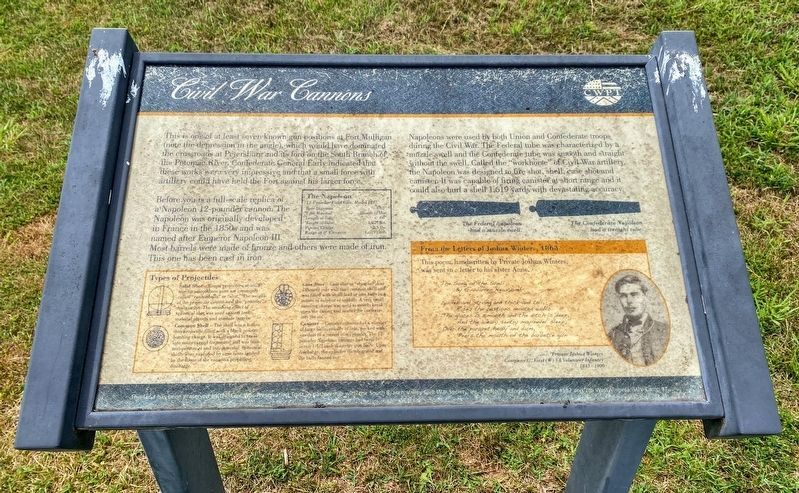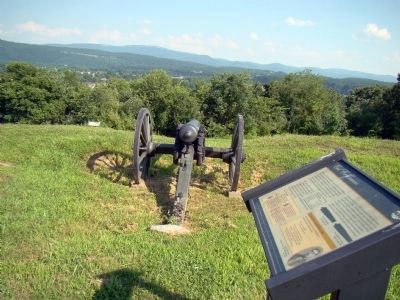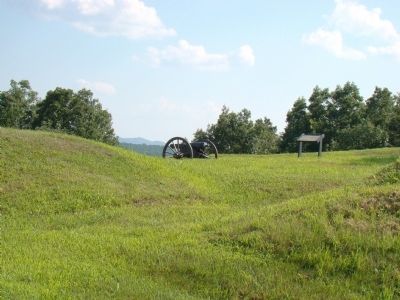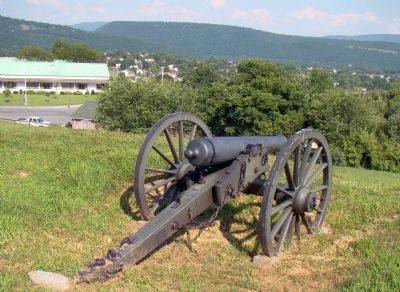Petersburg in Grant County, West Virginia — The American South (Appalachia)
Civil War Cannons
This is one of at least seven known gun positions at Fort Mulligan (note the depression in the angle), which would have dominated the crossroads at Petersburg and its ford on the South Branch of the Potomac River. Confederate General Early indicated that these works were very impressive and that a small force with artillery could have held the Fort against his larger force.
Before you is a full-scale replica of a Napoleon 12-pounder cannon. The Napoleon was originally developed in France in the 1850s and was named after Emperor Napoleon III. Most barrels were made of bronze and others were made of iron. This one has been cast in iron.
Napoleons were used by both Union and Confederate troops during the Civil War. The Federal tube was characterized by a muzzle swell and the Confederate tube was smooth and straight without the swell. Called the “workhorse” of Civil War artillery, the Napoleon was designed to fire shot, shell, case shot and canister. It was capable of firing canister at short range and it could also hurl a shell 1,619 yards with devastating accuracy.
The Napoleon 12-Pounder Field Gun, Model 1857 • Bore Diameter: 4.62" • Tube Material: Bronze or Iron • Length of Tube: 66" • Weight of Tube: 1,227 lbs. • Powder Charge: 2.5 lbs. • Range at 5° Elevation: 1,619 yards.
Types of Projectiles.
Solid Shot – Round projectiles of solid iron for smoothbore guns are commonly called “cannonballs” or “shot.” The weight of the projectile determined the “pounder” designation. The smashing effect of spherical shot was used against both material objects and animate targets.
Common Shell – The shell was a hollow iron projectile filled with a black powder bursting charge. It was designed to break into many ragged fragments, and was both anti-personnel and anti-material. Spherical shells were exploded by time fuses ignited by the flame of the cannon’s propelling discharge.
Case Shot – Case shot or “shrapnel” had a thinner side wall than common shell and was filled with small lead or iron balls in a matrix of sulphur or asphalt. A very small bursting charge was used to merely break open the casing and scatter the contents into the air.
Canister – Canister consisted of a number of large balls, usually of iron, packed with sawdust in a tinned iron cylinder. The 12-pounder Napoleon canister had twenty-seven 1½ inch diameter iron balls. Upon discharge, the cylinder disintegrated and the balls fanned out.
From the Letters of Joshua Winters, 1863. This poem, handwritten byPrivate Joshua Winters, was sent in a letter to his sister, Anne.
The Song of the Shell
By G. Warren Newcomb
Sullen and strong and thick and tall,
Rises the bastions moated walls.
The glaces is smooth and the ditch is deep,
And the weary sentry may never sleep;
Over the parapet heavy and dum,
Peers the mouth of the barbette gun
Erected by Civil War Preservation Trust.
Topics. This historical marker is listed in these topic lists: Forts and Castles • War, US Civil. A significant historical year for this entry is 1857.
Location. 39° 0.041′ N, 79° 8.343′ W. Marker is in Petersburg, West Virginia, in Grant County. Marker is on the Grant Memorial Hospital Parking Lot south of West Virginia Route 55. Touch for map. Marker is in this post office area: Petersburg WV 26847, United States of America. Touch for directions.
Other nearby markers. At least 8 other markers are within walking distance of this marker. A Strategic Location (within shouting distance of this marker); Parrott Rifle (within shouting distance of this marker); The Last Days of Fort Mulligan (within shouting distance of this marker); Protecting Supplies (within shouting distance of this marker); The Irish Brigade & the McNeill Rangers / The Civil War Comes to Hardy County (within shouting distance of this marker); Defending the Fort (about 300 feet away, measured in a direct line); Welcome to Fort Mulligan Civil War Site (about 300 feet away); The Impregnable Fortress (about 500 feet away). Touch for a list and map of all markers in Petersburg.
More about this marker. On the lower right is a portrait of “Private Joshua Winters, First (W) VA Volunteer Infantry (1843–1900).”
Credits. This page was last revised on December 17, 2020. It was originally submitted on December 21, 2008. This page has been viewed 3,530 times since then and 26 times this year. Last updated on August 30, 2020, by Bradley Owen of Morgantown, West Virginia. Photos: 1. submitted on December 17, 2020, by Shane Oliver of Richmond, Virginia. 2, 3, 4. submitted on December 21, 2008, by J. J. Prats of Powell, Ohio. • J. Makali Bruton was the editor who published this page.



